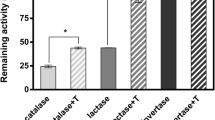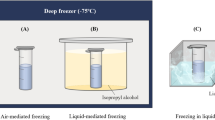Abstract
Aggregates formed during storage of freeze-dried β-galactosidase were compared with those formed in solutions. Freeze-dried β-galactosidase aggregated during storage in the presence of moisture, producing a protein precipitate which was soluble in guanidine hydrochloride solution but not in buffer solution. The protein precipitate dissolved in guanidine solution exhibited a large molecular size by high-performance size exclusion chromatography and converted to proteins of original size in the presence of dithiothreitol. It is suggested that the aggregation involves chemical interaction via covalent disulfide bonding. In contrast, β-galactosidase in aqueous solution aggregated without formation of protein precipitates. Soluble aggregates were converted to proteins of original size in guanidine solution without dithiothreitol, suggesting noncovalent bonding. The difference in aggregation behavior may be ascribed to the difference in the water:protein ratio. We propose that inactivation of β-galactosidase is due to formation of thermally denatured (unfolded) protein, which aggregates dependent on the water:protein ratio, either via noncovalent interactions at a high water:protein ratio in solution or via covalent interaction at a low water:protein ratio in the freeze-dried state.
Similar content being viewed by others

REFERENCES
S. Yoshioka, Y. Aso, K. Izutsu, and T. Terao. Stability of β-galactosidase, a model protein drug is related to water mobility, as measured by 17NMR. Pharm. Res. 10:103–108 (1993).
W. R. Liu, R. Langer, and A. M. Klibanov. Moisture-induced aggregation of lyophilized proteins in the solid state. Biotech. Bioeng. 37:177–184 (1991).
M. W. Townsend and P. P. DeLuca. Use of lyoprotectants in the freeze-drying of a model protein, ribonuclease A. J. Parent. Sci. Tech. 42:190–199 (1988).
M. W. Townsend and P. P. DuLuca. Stability of ribonuclease A in solution and the freeze-dried state. J. Pharm. Sci. 79:1083–1086 (1990).
M. W. Townsend and P. P. DeLuca. Nature of aggregates formed during storage of freeze-dried ribonuclease A. J. Pharm. Sci. 80:63–66 (1991).
M. J. Pikal, K. M. Dellerman, M. L. Roy, and R. M. Riggin. The effects of formulation variables on the stability of freezedried human growth hormone. Pharm. Res. 8:427–436 (1991).
M. S. Hora, R. K. Rana, and F. W. Smith. Lyophilized formulations of recombinant tumor necrosis factor. Pharm. Res. 9:33–36 (1992).
Author information
Authors and Affiliations
Rights and permissions
About this article
Cite this article
Yoshioka, S., Aso, Y., Izutsu, Ki. et al. Aggregates Formed During Storage of β-Galactosidase in Solution and in the Freeze-Dried State. Pharm Res 10, 687–691 (1993). https://doi.org/10.1023/A:1018951530927
Issue Date:
DOI: https://doi.org/10.1023/A:1018951530927



